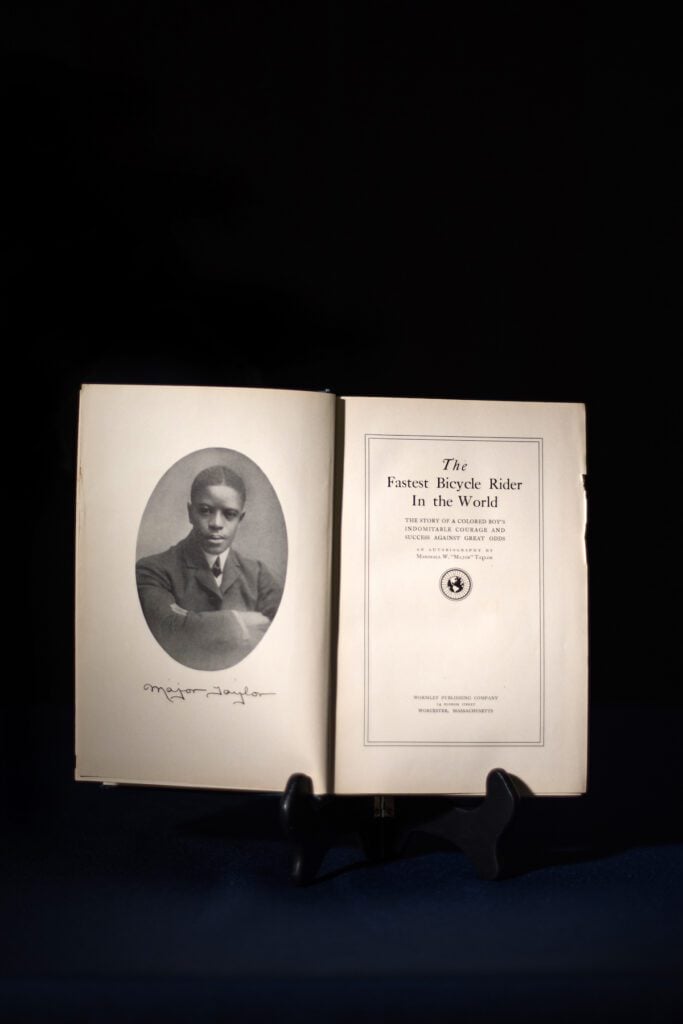A new exhibit at the Indiana State Museum, “Major Taylor: Fastest Cyclist in the World,” gives visitors an opportunity to learn about the world-renowned Hoosier cyclist. Along with insights into Taylor’s exercise schedules and the racial barriers he overcame in his short lifetime, visitors can “race” against Taylor via a stationary bike and see a recreation of Taylor’s locker at an Indianapolis racing track.
The highlight of the exhibit, however, is Taylor’s Peugeot bicycle, the only known bicycle owned and raced by the champion cyclist. Taylor raced the bike in his 1903 campaign in Paris and throughout Europe. The bike is on loan from the U.S. Bicycling Hall of Fame in Davis, California, an effort aided by a local avid cyclist, Dan Lee. Lee, a board member for the hall of fame — who was also a major force in the creation of the Major Taylor mural in downtown Indianapolis — worked with Kisha Tandy, curator of social history for the Indiana State Museum, to get the bike to Indianapolis. Along with the bike, the hall of fame is also loaning an original copy of Taylor’s 1928 autobiography “The Fastest Bicycle Rider in the World,” which was inscribed to civil rights pioneer W.E.B. Du Bois.

Both Lee and Tandy hope guests get a better understanding of what Taylor went through as a professional cyclist, including racist harassment and even physical attacks. To put it into context: Taylor came on the scene nine years before Jack Johnson became the first Black heavyweight champion and nearly 50 years before Jackie Robinson broke baseball’s color barrier.
“Amid rampant racism and segregation … Taylor broke dozens of world records on bicycle tracks in the United States, Europe and Australia while showing the world great physical and mental strength, brilliant tactics, bravery and class,” Tandy said.
Beyond learning about Taylor’s professional and personal life — his daughter, Rita Sydney, loaned letters written between her parents to be included in the exhibit — “Fastest Cyclist in the World” also touches on Taylor’s legacy today. Video panels show cyclists, many of whom are African American, discussing Taylor’s impact on their lives. Justin Williams, a professional cyclist from Los Angeles, shares that the first team he rode for was named after Taylor. Lee works for a bicycle company, SRAM, which sponsors Williams’ current team, and was able to get one of their championship jerseys included in the exhibit.
“I think the exhibit has a perfect timing,” Lee said. “It gives people a chance to look at our history in a very fair way and see where we’ve been as a nation and some of the progress we’ve made and the challenges that remain. And it does that through Major Taylor, someone who rose above the challenges in front of him to become a pioneer and did so in a way that he never lost his integrity.”
Though Taylor died essentially penniless in a Chicago hospital when he was 53, the Indiana State Museum exhibit showcases his legacy and a message of perseverance that people can learn from today.
“His story is really sad in that he died young and lost a lot of his wealth, but his spirit was never defeated,” Lee said. “It continues to shine on. I always love being able to discover new people in history who inspire me, and this is an opportunity for many people to discover Major Taylor.”
Contact staff writer Breanna Cooper at 317-762-7848. Follow her on Twitter @BreannaNCooper.










